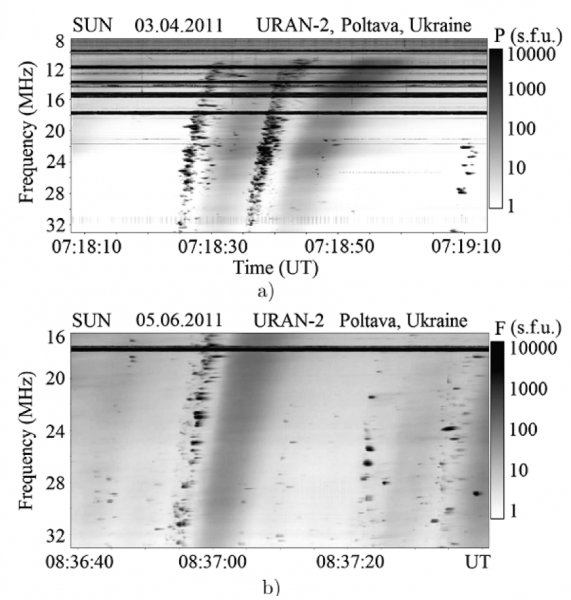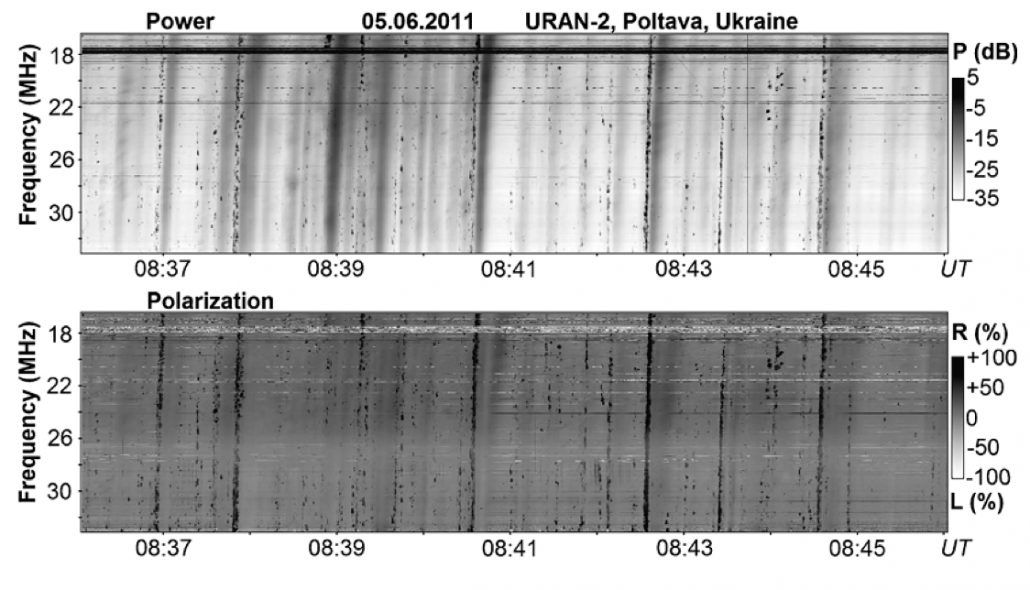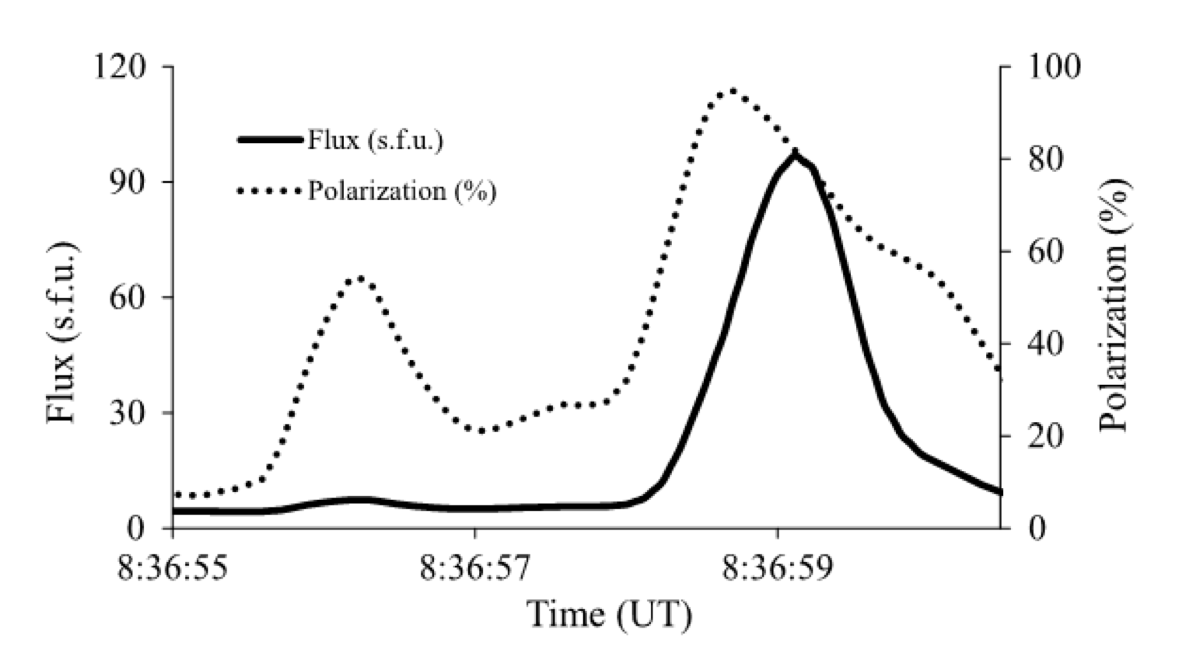A large number of Type IIIb–III pairs, in which the first component is a Type IIIb burst and the second one is a Type III burst, are often observed during decameter Type III burst storms. From the beginning of their detection, the question of whether the components of these pairs are the first and the second harmonics of radio emission or not has remained open. We discuss properties of decameter IIIb–III pairs in detail to answer this question. The components of these pairs, Type IIIb bursts and Type III bursts, have essentially different durations and polarizations. At the same time their frequency drift rates are rather close, provided that the drift rates of Type IIIb bursts are a little larger than those of Type III bursts at the same frequency. Frequency ratios of the bursts at the same moment are close to two. This points at a harmonic connection of the components in IIIb–III pairs. The physical aspects of observational properties of decameter IIIb–III pairs are discussed and pros and cons of harmonic character of Type IIIb bursts and Type III bursts in IIIb–III pairs are presented. We conclude that practically all properties of the IIIb–III pair components can be understood in the framework of the harmonic relation of the components of the IIIb–III pairs.
Observations
In this article IIIb–III pairs (Figure 1), which were observed by the URAN-2 radio telescope (Poltava, Ukraine) in April (1-7), June (3-6), and September (4-7) 2011 during storms of Type IIIb and Type III bursts (Figure 2), are discussed (Melnik et al., (2015)).
 Figure 1. Dynamic spectra of the IIIb–III pairs observed on 3 April (a), 5 June (b) 2011.
Figure 1. Dynamic spectra of the IIIb–III pairs observed on 3 April (a), 5 June (b) 2011.
Observations were mainly made from 5:30 to 14:30 UT these days. 143, 106, and 56 IIIb-III pairs were analyzed in April, June, and September, respectively. Averaged frequency ratios for Type III bursts and Type IIIb bursts at one and the same time were derived for the days of maximum IIIb–III numbers in April, June, and September 2011. They are equal to 1.94 ± 0.07, 1.93 ± 0.04, and 1.87 ± 0.09 for 3 April (44 pairs), 5 June (41 pairs), and 5 September (23 pairs), respectively. In the case where Type IIIb bursts are fundamentals and Type III bursts are harmonics, the frequency ratio should be 2:1.
We measured frequency drift rates, durations, polarizations, and fluxes of bursts in frequency bands 10 – 14 MHz, 14 – 18 MHz, 18 – 22 MHz, 22 – 26 MHz, 26 – 30 MHz, and 30 – 33 MHz. These bursts parameters did not change significantly on month of observations.
Frequency dependences of drift rates for both components are linear \(d{f}/ d{t} \approx – Af \) (\(0.8{s^{ – 1}} < A < 0.18{s^{ – 1}}\)) and drift rates for Type IIIb bursts were higher than for Type III bursts. As a rule, they changed from 2 MHz/s at 12 MHz to 4 MHz/s at 31 MHz. If components of IIIb-III pairs are harmonically connected then the ratio of their drift rates at one and the same time should be equal 2 independently of the model of the solar corona. We derived that these drift-rate ratios are equal to 1.9, 1.8, 1.6 for 3 April, 5 June, and 5 September, respectively. Taking into account errors in the measurement of drift rates, there is quite a good correspondence.
Durations of both Type IIIb and Type III bursts decreased with frequency but steeper for Type III bursts. Durations of Type III bursts were some times (4-7) larger than those for Type IIIb bursts. This property does not know in what way to be understood if both components are harmonically connected. Their different frequency dependences seem to suggest different physical nature of Type IIIb and Type III durations. If the latter is defined by a spatial size of corresponding electron beam then the former is determined by collision rate. Such difference contradicts harmonic character of components of IIIb-III pairs.
 Figure 2. Fragment of Type IIIb bursts–Type III bursts storm with plenty of IIIb–III pairs on 5 June 2011.
Figure 2. Fragment of Type IIIb bursts–Type III bursts storm with plenty of IIIb–III pairs on 5 June 2011.
For analyzed IIIb-III pairs flux for the first component is higher than that for the second component as a rule and frequency dependence is power-like \(I \propto {f^{ – \beta }}\) with the exponent of \(\beta \propto 0.6 – 1\). Fluxes of components change from 10 s.f.u. to 1000 s.f.u.
Polarizations of Type IIIb and Type III bursts differed greatly. Type III bursts in IIIb-III pairs have polarizations 10-15% and Type IIIb have polarizations 40-60%. This can be understood easily in plasma mechanism of radio emission if components are harmonically connected. Polarizations of both Type III and Type IIIb bursts do not depend on frequency. At the same their time dependences are different. Polarizations of Type III bursts are practically constant over the duration of the bursts. At the same time, polarizations of Type IIIb bursts achieve their maxima very quickly after the beginning of the bursts (Figure 3). After that their polarizations decrease regularly. So any polarization maximum is always preceding the flux maximum for all Type IIIb bursts. Such feature can be understood in plasma mechanism of radio emission. Really, at the moment of first arrival of fast electrons in a certain place, the spectral energy density of Langmuir waves is centered at large phase velocities or small wavenumbers. Langmuir waves with large wavenumbers are practically absent. For this reason, practically all Langmuir waves are transformed into electromagnetic waves of O-modes. With time, electrons with smaller velocities come to this point and the number of Langmuir waves with large wavenumbers will be increasing. As a consequence, the number of X-waves into which these Langmuir waves are transformed will increase and thus burst polarization will decrease. Such a behavior of Type IIIb bursts is visible in Figure 3.
 Figure 3. Flux (solid curve) and polarization (dotted curve) profiles for a Type IIIb burst observed on 5 June 2011 at a frequency of 23 MHz.
Figure 3. Flux (solid curve) and polarization (dotted curve) profiles for a Type IIIb burst observed on 5 June 2011 at a frequency of 23 MHz.
Conclusion
The properties of decametre IIIb–III pairs can be considered as such that Type IIIb bursts are the fundamental and Type III bursts are the second harmonic. In favour of this is the fact that the frequency ratios of the IIIb–III components are about two. As a consequence of the harmonic character of the components, the frequency drift ratios are also close to two. We consider as very important evidence of the harmonic structure of the IIIb–III pairs high polarizations of Type IIIb bursts and small polarizations of Type III bursts. Accompanying properties of these bursts, namely maximum polarization in advance of flux maximum for Type IIIb bursts and larger Type IIIb frequency drifts in comparison of Type III bursts frequency drifts, can also be explained. The presence of Type IIIb fine structure in the form of stria bursts and its absence for Type III bursts can be explained by small-scale inhomogeneity of coronal plasma (Loi et al. (2014)). At the same time there is an open question concerning the essential distinction of the IIIb–III component durations. Moreover, it is unclear what the cause is of the different physical phenomena that determine these durations. Nevertheless, in our opinion IIIb–III pairs are harmonic components because most of the observational indications are in favour of this idea.
References
Loi, S.T., Cairns, I.H., Li, B.: 2014, Astrophys. J. 790, 67
Melnik, V. N., Brazhenko, A. I., Frantsuzenko, A.V., et al.: 2018, Sol.Phys., 293,26
*Full list of authors: Valentin Melnik, Anatoliy Brazhenko, Anatoliy Frantsuzenko, Vladimir Dorovskyy, and Helmut Rucker
